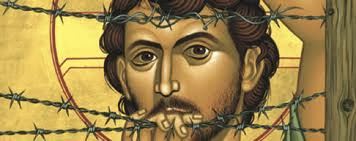Visiting Christ the Prisoner: “Council”

Editor’s Note: This is Part III in a series called “Visiting Christ the Prisoner: A Look into Prison Ministry in Bolivia”. Read Part I and Part II.
Each of the six prisons are unique, but in each of them inmates govern themselves with an elected system of delegates who oversee various parts of the prison society. The delegates of the work groups, for example, manage the different workshops where inmates work to cover the costs of food and rent for themselves and their families.
In this post, missioner Jeff shares with us a story of his time in El Centro de Reinserción Social de San Pablo. Home to around 350 men, San Pablo is located in the neighboring town of Quillacollo, and is one of the six prisons that Jeff regularly visits as part of his ministry in Cochabamba, Bolivia.
Even though each prison has their elected system of delegates, each group of delegates functions very differently. A great example of this is the preparations for the fair/expo in La Paz, FIPAZ, where I sold artisan products from the prisons this past December.
Part of coordinating the shipping of products and sales in La Paz was meeting with a contact person in each prison to prepare products to send. In San Sebastián, I met individually with the head delegate of the zapatería and the head delegate of the artesanía who then coordinated what products to send within their respective work groups; in San Antonio, I met the head delegate of trabajo who shared the information with each of the work groups.
In San Pablo, however, I met initially with a friend of mine who is the head delegate of that prison. He then called for what seemed like the entire delegate council – it was actually just the group of delegates from the artesanía y carpentaría. Even so, what had been an easy and relaxed meeting in the other prisons became an intense discussion among myself and the ten delegates gathered.
The meeting felt something like this:
 |
| Lord of the Rings reference: Council of Elrond |
The delegates each took turns voicing their concerns, mainly about transporting some fragile wood crafts by bus to La Paz, and we worked through the issues one at a time. It was a daunting task, reassuring the delegates that all would be well during the three weeks I was about to spend in La Paz.
Though the system of delegates must work closely together in each prison, it was something special to be seated among them in San Pablo as they reached the decision to send their products to sell. In many prisons, one representative makes decisions for the group as whole, but there at San Pablo, they came to what was truly a group decision.
Seeing the head delegate specifically defer to the group of other delegates in this decision-making process made me reflect on how we often make decisions in organizations with a similar hierarchical structure. The head delegate was not merely listening to the opinions of others before reaching his decision; he fully deferred to the other members of the group as we reached our decision.
Seated among the group of delegates, I can’t help but think that I saw the decision-making style of Francis and the original lesser brothers.
Although separated by titles of head delegate, work delegate, the head delegates of the carpentry and artisan workshops, and a handful of assistant delegates, they viewed and treated each other as equals, brothers gathered together in humility and respect. The value was not placed on positions of power, but instead on a communal or fraternal decision-making process.
It was a beautiful example of community life to witness.
Featured image: “Christ of Maryknoll” by Br. Robert Lentz, OFM
Tagged in:
